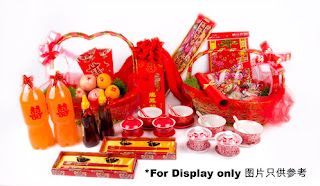新郎在迎娶他的新娘之前,通常须要通过一系列的有趣游戏测试, 来证明对未来的妻子的爱.
以下是我们将与您分享的一些游戏,这对您的新郎和伴郎来说肯定会有挑战性。
没钱,没宝贝!
游戏通常开始于新郎需要“贿赂” 她的伴娘。 新郎和他的兄弟们须与伴娘一起进行各种有趣的讨价还价游戏。红包的价钱通常是 RM888或 RM 999 ; 因为8和9是中国文化中的幸运数字它也意味着好运。 伴娘感到满意之后,才打开大门欢迎他们进入房子
酸甜苦辣
婚姻是关于两个人一起经历生活中的起伏和酸,甜,苦,辣。所以我们可以做些有创意的饮料或食物.你可以从中药店得到苦粉, 甜味可以用炼乳代替,苹果醋代表酸味,红辣椒可以 很好地代表辛辣。每试一种口味, 就要求新郎讲每一个与新娘联系的珍贵回忆.
问答环节
新郎必须正确的回答有关新娘的每一个问题。 对于每一个不正确的答案,新郎和他的随行人员必须要么仰卧起坐/或者要求新郎在结婚后做些什么。
跳Limbo
没有什么比观看一群成年男子试图在一根绳子或一块木头下面挣扎弯腰来得更有趣的了,而每一个通过的人都会得到人们的欢呼声。这是一个有趣游戏测试, 男人也可以通过游戏来证明对未来的妻子的爱!
爱的宣言
:
就在新郎“迎娶”她之前,请新郎为新娘写一首浪漫的爱情诗,一份的信息,列出他爱她/她需要嫁给他的五个理由.
Tips.
1.新娘的姊妹朋友在闖關遊戲中故意阻饒新郎接新娘,為討吉利新郎會給予她們紅包,這舉動稱之為「討喜」。
Before the groom can claim his bride, he usually has to undergo a
series of test in the form of fun game, also called "door games". In
this section, the bridesmaids "ji mui" will pretend to prevent the
groom & his groomsmen"heng dai" from taking the bride away from
her home. This ceremony aimed to make the groom prove his love again to his
future wife. Here are some games we are going to share with you that will
surely be challenging for your groom and groomsmen.
No money, no honey!
The door games usually start with the groom needing to “bribe” his
way to his loved one. The groom and his entourage have to go through rounds of
fun bargaining with the bridesmaids. Choose your “Lai See” (red packet)
carefully; $888 (8 is the lucky number in Chinese culture!) or $999 (the number
9 represents ‘eternity’ in Chinese) and so on are meant to represent good
fortune. After the bridesmaids is satisfied with the Lai See amount, the gates
open to welcome them into the house.
The Four Flavors of Life
Marriage is about going through ups and downs, through health and
sickness – sour, sweet, bitter and hot/spicy (酸甜苦辣) – together. Be creative and whip up some drinks
or food that have each flavour – salt, sweet, spicy & bitter – you can get
bitter powder from the Chinese traditional medicine shop, condensed milk can be
the sweetness, apple cider vinegar represents sourness and red chilli is a good
representation of spiciness. Spice it up by asking for the groom to associate a
memory with the bride to each flavour. Prepare some water for the “Heng Dai”
just in case the concoction becomes too strong for them.
Q&A
The groom must answer correctly every question asked about the
bride and their relationship. For every incorrect answer, the groom and his entourage
will have to either do presses or sit ups/or what the groom will carry out
after the marriage.
Doing the Limbo
Nothing is more fun than watching a bunch of grown men try to
limbo their way beneath a string or piece of wood while everyone one cheers
them on through fits of laughter. It’s a challenge of how far a man will bend
over for his loved one!
Declaration of Love
Right before the groom “picks” her up, ask him to write a love
poem and prepare a romantic message to profess his love for his wife-to-be in
the form of a love song. If he doesn’t consider himself as a love poet like
Shakespeare or Taylor Swift, simply get him to list five reasons he loves her /
she needs to marry him









